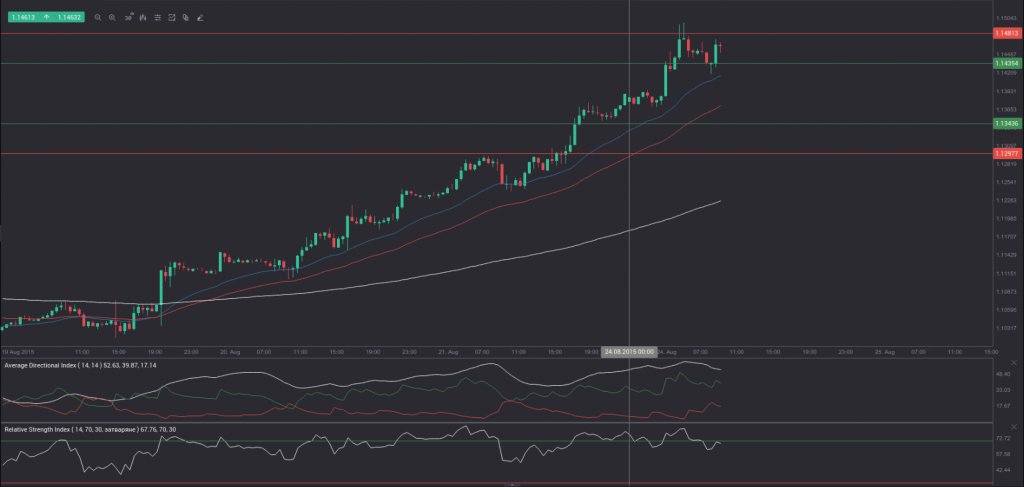Friday’s trade saw EUR/USD within the range of 1.1226-1.1394. The pair closed at 1.1389, soaring 1.32% on a daily basis and marking the third consecutive trading day of gains. The daily rate of increase has been the most considerable one since June 8th, when the cross appreciated 1.61%. The daily high has also been the highest level since June 18th, when the cross registered a high of 1.1438.
At 7:07 GMT today EUR/USD was up 0.71% for the day to trade at 1.1465. The pair overshot the upper range breakout level (R4), as it touched a daily high at 1.1499 at 3:05 GMT. It has been the highest level since February 5th, when a daily high of 1.1500 was reached.
No relevant macroeconomic reports and/or events are scheduled for today.
Correlation with other Majors
Taking into account the week ended on August 23rd and the daily closing levels of the major currency pairs, we come to the following conclusions in regard to the strength of relationship:
EUR/USD to NZD/USD (0.9223, or very strong)
EUR/USD to USD/CAD (0.8341, or very strong)
EUR/USD to GBP/USD (0.5976, or strong)
EUR/USD to AUD/USD (-0.7035, or strong)
EUR/USD to USD/CHF (-0.9578, or very strong)
EUR/USD to USD/JPY (-0.9763, or very strong)
1. During the examined period EUR/USD moved almost equally in one and the same direction with NZD/USD, while moving almost equally in the opposite direction compared to USD/CHF and USD/JPY.
2. EUR/USD moved strongly in the opposite direction compared to AUD/USD during the past week.
3. EUR/USD moved strongly in one and the same direction compared to GBP/USD during the period in question.
Bond Yield Spread
The yield on German 2-year government bonds went as high as -0.242% on August 21st, or the highest level since August 19th (-0.241%), after which it slid to -0.250% at the close to add 1.1 basis points (0.011 percentage point) on a daily basis. It has been the first gain in the past three trading days.
The yield on US 2-year government bonds climbed as high as 0.662% on August 21st, after which it fell to 0.621% at the close to lose 3.6 basis points (0.036 percentage point) for the day, while marking a third straight trading day of decrease.
The spread between 2-year US and 2-year German bond yields, which reflects the flow of funds in a short term, shrank to 0.871% on August 21st from 0.918% during the prior day. The August 21st yield spread has been the lowest one since July 14th, when the difference was 0.868%.
Meanwhile, the yield on German 10-year government bonds soared as high as 0.601% on August 21st, after which it slid to 0.572% at the close to lose 1.3 basis points (0.013 percentage point) compared to August 20th, while marking a third straight trading day of decline.
The yield on US 10-year government bonds climbed as high as 2.091% on August 21st, after which it slipped to 2.045% at the close to lose 2.8 basis points (0.028 percentage point) on a daily basis, while marking a third consecutive day of decrease.
The spread between 10-year US and 10-year German bond yields narrowed to 1.473% on August 21st from 1.488% during the prior day. The August 21st yield difference has been the lowest one in more than two months.
Daily and Weekly Pivot Levels
By employing the Camarilla calculation method, the daily pivot levels for EUR/USD are presented as follows:
R1 – 1.1404
R2 – 1.1420
R3 (range resistance – green on the 30-minute chart) – 1.1435
R4 (range breakout – red on the 30-minute chart) – 1.1481
S1 – 1.1374
S2 – 1.1358
S3 (range support – green on the 30-minute chart) – 1.1343
S4 (range breakout – red on the 30-minute chart) – 1.1297
By using the traditional method of calculation, the weekly pivot levels for EUR/USD are presented as follows:
Central Pivot Point – 1.1266
R1 – 1.1517
R2 – 1.1645
R3 – 1.1896
S1 – 1.1138
S2 – 1.0887
S3 – 1.0759






